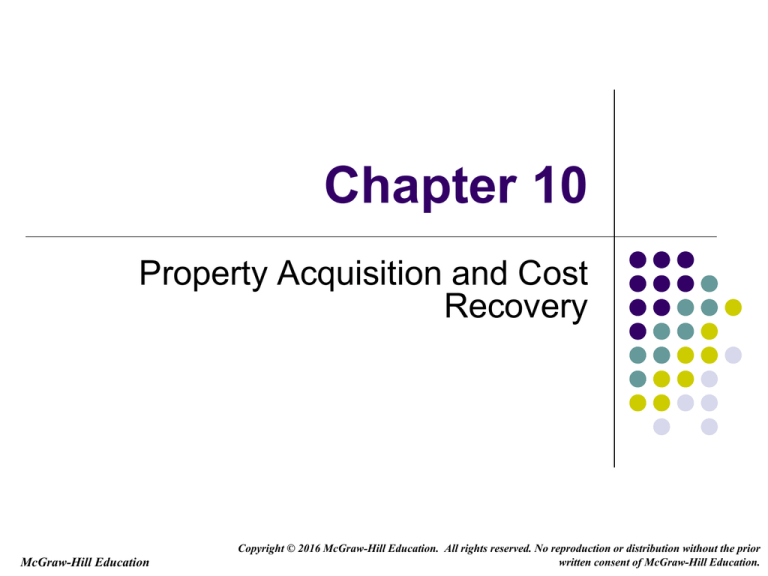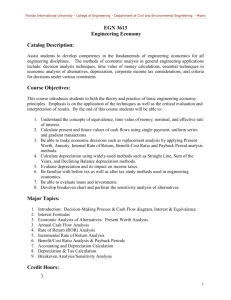
Chapter 10
Property Acquisition and Cost
Recovery
McGraw-Hill Education
Copyright © 2016 McGraw-Hill Education. All rights reserved. No reproduction or distribution without the prior
written consent of McGraw-Hill Education.
Learning Objectives
1.
2.
3.
4.
5.
Explain the concept of basis and adjusted basis and
describe the cost recovery methods used under the tax
law to recover the cost of personal property, real
property, intangible assets, and natural resources
Determine the applicable cost recovery (depreciation)
life, method, and convention for tangible personal and
real property and calculate the deduction allowable
under basic MACRS
Explain the additional special cost recovery rules
(§179, bonus, listed property) and calculate the
deduction allowable under these rules.
Explain the rationale behind amortization, describe the
four categories of amortizable intangible assets, and
calculate amortization expense
Explain cost recovery of natural resources and the
allowable depletion methods
2
Cost Recovery
Businesses must capitalize the cost of assets
with a useful life of more than one year on the
balance sheet rather than expense the cost
immediately
Also known as depreciation, amortization, or
depletion – depending upon the underlying
nature of asset
Business use these methods to recover cost
of assets due to wear, tear and obsolescence
of assets
3
Cost Recovery
Different methods to recover the costs of
assets
Depreciation - Deducting the cost of tangible
personal and real property (other than land)
over a specific period of time
Amortization - Deducting the cost of intangible
property over a specific period of time
Depletion - Deducting the cost of natural
resources over time
4
Cost Recovery
Basis for Cost Recovery –
Once the use of purchased assets is started,
recouping the cost of assets also starts
Cost basis reduces when cost is recovered
through Cost Recovery Deductions which is called
Assets Adjusted Basis or Tax Basis
Assets Adjusted Basis = Assets Initial Cost or
Historical basis minus Accumulated Depreciation
(Amortization or Depletion)
5
Basis Example
Scrap-Happy Inc., a scrapbooking retail
chain, purchased an old office building for
$175,000 for use in expanding its current
operations. An additional $15,000 was spent
painting and remodeling the building in
preparation for its opening.
Two years later, a Scrap-Happy employee
discovered that several leaks in the roof were
causing serious water damage to the store’s
inventory; the company spent $50,000 to re-roof
the building.
Every six months, Scrap-Happy pays $500 to
have the carpet professionally cleaned.
6
Basis Example (cont.)
What is the original basis of the building?
$175,000 initial cost
+ $15,000 painting and remodeling
$190,000 Original Basis
What effects do the other two transactions
have on the original basis?
$50,000 re-roofing expense: Added to basis (extends
the useful life of the building)
$500 biannual carpet cleaning: No effect on basis
(Expensed immediately routine maintenance)
7
Cost Recovery
8
Depreciation
Before 1981, tax depreciation methods closely
resembled financial accounting methods which
required businesses to determine “Salvage Values”
and “Useful Lives”
In 1981, ACRS – Accelerated Cost Recovery System
was introduced to depreciate assets over
predetermined, fixed recovery periods
Today, businesses calculate their tax depreciation
using the MACRS- Modified Accelerated Cost
Recovery System – which is pronounced “makers” by
tax accountants
9
Depreciation
To compute MACRS depreciation for an asset,
following are to be known
asset’s original cost,
applicable depreciation method,
asset’s recovery period (or depreciable “life”),
applicable depreciation convention
(depreciation deductible in the year of
acquisition and the year of disposition)
10
Depreciation
Personal Property Depreciation
Includes all tangible property such as computers,
automobiles, furniture, machinery and equipment,
other than real property
Personal property (not real property) and
personal use property (used for personal
purposes) not the same
11
Depreciation
Depreciation Method
Three acceptable methods for depreciating
personal property
200 percent (double) declining balance
150 percent declining balance
straight-line
12
Depreciation
Depreciation Recovery Period
For financial accounting purposes an assets
recovery period (depreciable life) is based on its
taxpayer-determined estimated useful life
For tax purposes, an assets recovery period is
predetermined by IRS in the Rev. Proc. 87-56
which helps payers to categorize each of their
assets based upon the property’s description
13
Depreciation
Once the business has determined the
appropriate categories for its assets, it can
use the Revenue Procedure to identify the
recovery period for all assets in a particular
category
14
Depreciation
15
Depreciation
16
Depreciation
Depreciation Conventions
Half-year Convention
One–half year’s depreciation is allowed in first and last
year of an asset’s life
An IRS depreciation tables automatically account for
the half-year convention in year of purchase and
disposition
If an asset is disposed of before it is fully depreciated,
only one-half of the table’s applicable depreciation
percentage is allowed in the year of disposition
17
Depreciation
Mid–Quarter Convention
Steps to determine whether the mid–quarter
convention applies
1)
2)
3)
Sum of the total basis of tangible personal property that
was placed in service during the year
Sum of the total basis of tangible personal property that
was placed in service during the fourth quarter
Divide step (2) by step (1), if the quotient is more than
40%, then the business must use this method or else
half–year convention is used
18
Depreciation
Calculating depreciation for personal property
Locate the applicable table provided in Rev. Proc. 8757
Select the column that corresponds with the assets
recovery period
Find the row identifying the year of the assets
recovery period
Applying the half-year and mid–quarter convention
Half-year convention for year of disposition
Mid-quarter convention for year of disposition
19
Depreciation
20
Depreciation
21
Depreciation
22
Depreciation Example
In 2015, Scrap-Happy purchased and placed in
service the following assets:
Asset
Cost
Date placed in service
Di-Cut Machine
$3,500
February 2 (1st Qtr.)
Computer
$1,200
October 25 (4th Qtr.)
• What is the recovery period for each of the assets?
Computer = 5 years
Di-Cut Machine = 7 years
Which convention should Scrap-Happy use to
determine depreciation for 2015?
Answer: Half-year
$1,200 4th qtr. assets/$4,700 total assets = 25.53% < 40%
23
Depreciation Example
Now assume all the same facts, except that the computer
was purchased in February and the machine in October, as shown:
Asset
Cost
Date placed in service
Recovery Period
Computer
$1,200
February 2 (1st Qtr.)
5 Years
Di-Cut Machine
$3,500
October 25 (4th Qtr.)
7 Years
What convention should be used in computing
depreciation for the year?
Answer: Mid-quarter
$3,500 4th qtr. assets/$4,700 total assets = 74.46% > 40%
How much depreciation can they take for each of
the assets in 2015?
Computer: $1,200 x 35%* = $420
Di-Cut Machine: 3,500 x 3.57%* = $125
*See respective mid-quarter MACRS tables for rates
24
Depreciation
Real Property
It uses mid–month convention and depreciated
using straight line method
25
REAL PROPERTY:
Depreciation Example
On July 12, Scrap-Happy purchases and
places in service a warehouse and the land it
resides on for $170,000 ($120,000 is allocated
to the building and $50,000 to the land).
What is the amount of depreciation on the
property for the first year?
Answer: $120,000 x 1.177% = $1,412
1.177% is the rate given in the nonresidential real property
MACRS table under the column for the 7th month*
Land is not included in the calculation because it is
not depreciable
26
Depreciation
Immediate Expensing
This incentive is commonly referred as §179
expense or immediate expensing election
Limits on immediate expensing
Choosing the assets to immediately expense
Bonus Depreciation
To stimulate the economy, policy makers
occasionally implement bonus depreciation
27
Depreciation
Listed Property
Business can use the following steps to determine
its current depreciation expense for the asset
1)
2)
3)
4)
5)
Compute depreciation for the year if it drops to 50% or
below using the straight-line method
Compute amount to be deducted if straight line method is
used over ADS recovery period for all prior years (limited to
business – use percentage)
Compute the amount of depreciation, taxpayer actually
deducted on the assets for all prior years
Subtract amount of step 2 from step 3, which is prior year
accelerated depreciation in excess of straight line
depreciation
Subtract amount of step 4 from step 1 which is business’s
allowable depreciation expense on the asset for that year
28
Depreciation
Luxury Automobiles
29
Amortization
For intangible assets businesses recover cost of
the asset through amortization
Intangible assets in the form of capitalized
expenditures, such as capitalized research and
experimentation (R&E) costs or covenants do not
have physical characteristics
Intangible assets has one of the following
characteristics
Section 197 Intangibles
Start-up expenditures and organizational costs
Research and experimentation costs
Patents and Copyrights
30
Amortization
Section 197 intangibles
According to §197, these assets have a recovery
period of 180 months (15 years), regardless of
their actual life
Uses full month convention allows taxpayers to
deduct an entire month’s worth of amortization for
the month of purchase and all subsequent months
in the year
31
Amortization
Organizational Expenditures and Start-up
Costs
Organizational expenditures include expenditures
to form and organize a business in the form of a
corporation or a partnership and are incurred prior
to the starting business
Start-up costs are costs businesses incur to, start
up a business
32
Amortization
Research and Experimentation Expenditures
To stay competitive, businesses often invest in
activities which will generate innovative products or
significantly improve their current products or
processes
Businesses may immediately expense these costs
or they may elect to capitalize and amortize these
costs using the straight-line method over a period of
not less than 60 months, beginning in the month
benefits are first derived from the research
33
Amortization
Patents and Copyrights
It depends on the way how business directly
purchases the patent or copyright or whether itself
creates the intangibles
Businesses directly purchasing patents or
copyrights amortize the cost over the remaining
life of the patents or copyrights
Businesses receiving “self-created” patents or
copyrights amortize the cost or basis of the selfcreated intangible assets over the shorter of the
legal life or remaining useful life
34
Amortization
35
Depletion
A method used to recover their capital
investment in natural resources
Businesses compute annual depletion expense
under both the cost and percentage depletion
methods and they deduct the larger of the two
Taxpayers must estimate or determine the
number of units or reserves that remain at the
beginning of the year and allocate a pro rata
share of that basis to each unit that is
extracted during the year
36
Cost Depletion Example
Scrap-Happy purchases a tract of forest land which
they plan to use to harvest trees for the production
of scrapbook paper. It is estimated that the tract
contains 30,000 board feet of timber. The original
cost of the property is $75,000, of which $60,000 is
allocated to the timber and $15,000 to the land.
What is the cost depletion per board foot?
Answer: $60,000 basis/30,000 ft = $2/ft
If the company uses 10,000 board feet during the
first year, how much will they expense under the
cost depletion method?
Answer: 10,000 ft. x $2/ft = $20,000
OR $60,000 basis x 33.33% resource used = $20,000
37
Depletion
Once entire cost is recovered, businesses are
not allowed to use cost depletion to determine
depletion expense
The amount of percentage depletion for a
natural resource business activity is
determined by multiplying the gross income
from the resource extraction activity by a fixed
percentage based on the type of natural
resource as indicated in Exhibit 10-14
38
Depletion
39





